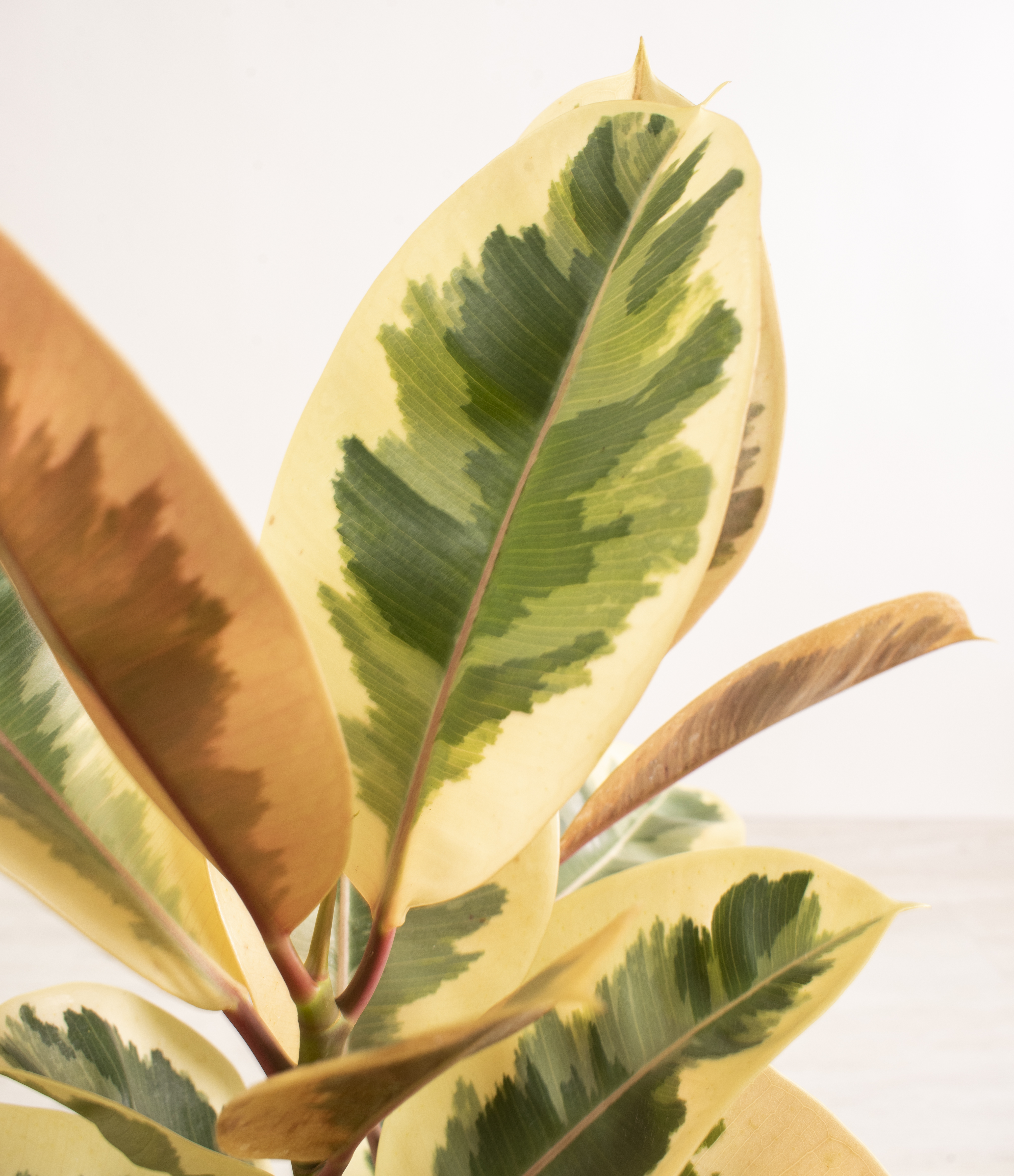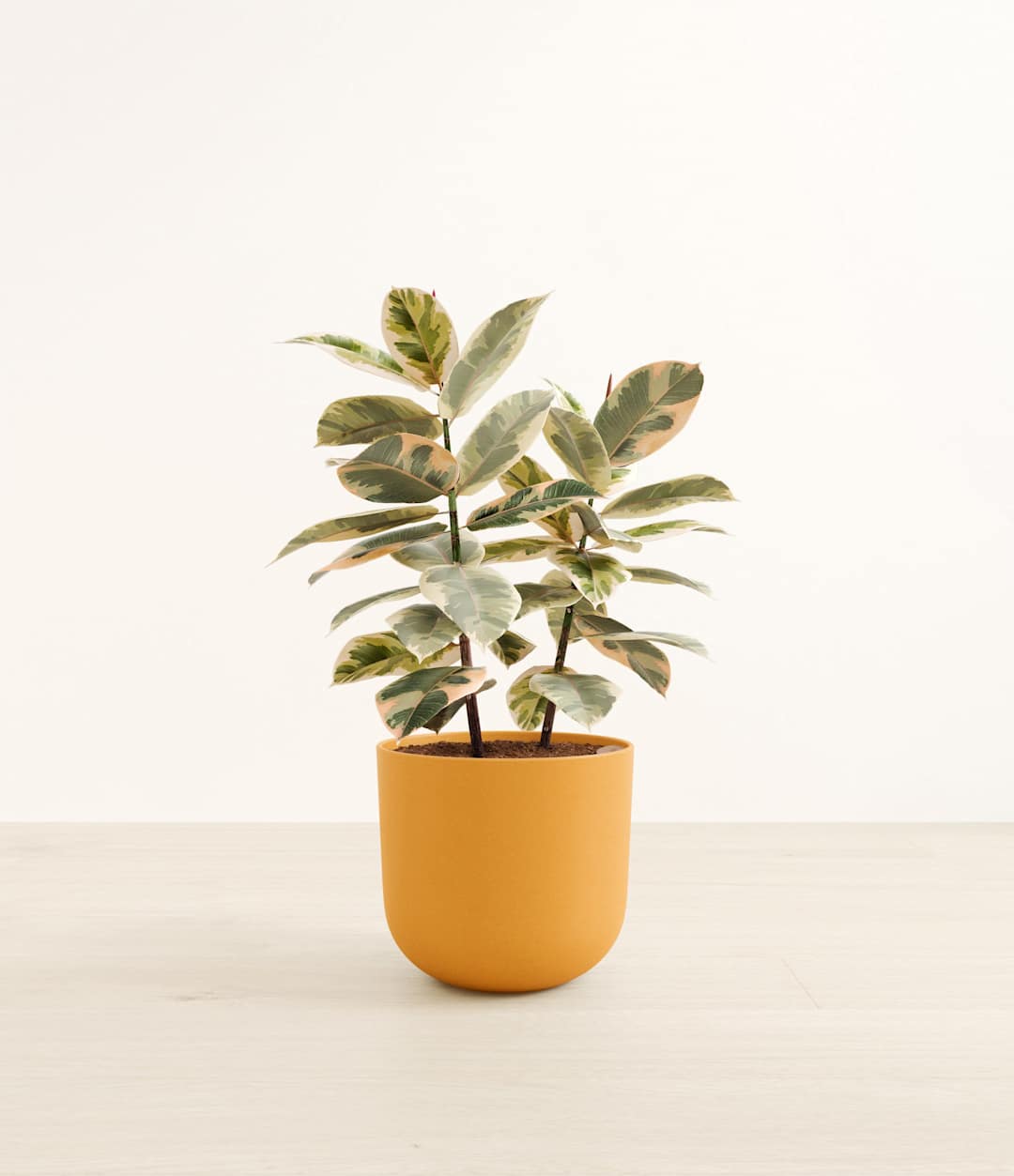Ficus Tineke Care
Shop this plantAbout Ficus Tineke
The exquisite Ficus Tineke is native to North East India and is renowned for its colourful leaves and milky sap, which can be used in the production of rubber. It belongs to the Moraceae, or Mulberry, family. This perennial plant features waxy, evergreen leaves in soft shades of pink, green, and cream, making it a striking addition to any home
Other common names
- Tineke Rubber Tree
- Tineke Fig
- Indian Rubber Fig
- Ficus Elastica
- Variegated Rubber Tree
How Often Should I Water My Ficus Tineke?
Ficus Tineke prefers slight underwatering to overwatering, as excess water can quickly lead to root rot. Fortunately, with easyplant, keeping your Ficus Tineke hydrated is effortless. Simply check the reservoir once a month, top it up when empty, and you’re all set!
Ficus Tineke Light Needs
Ficus Tineke grows best in a space with bright, direct sunlight streaming indoors, but it can also adapt well to bright, indirect light, where the rays are softened. Avoid placing it in areas with poor light or in rooms without natural daylight.
The ideal spot is near an east-facing window, or a little way back from a south- or west-facing window where it will still catch the light. If the afternoon sun becomes too strong, a sheer curtain can help diffuse the rays and protect the leaves.
Ficus Tineke Plant Care
The more indirect light your Ficus Tineke receives, the better chance its leaves will hold onto their beautiful pink and cream variegation. To keep it growing evenly, give the leaves an occasional wipe with a soft, damp cloth to remove dust, and turn the pot a quarter turn once a month. This way, the plant gets light on all sides and develops a balanced shape.
How Big Will My Ficus Tineke Grow?
Ficus Tineke growth is not only about the plant’s overall size but also about the development of its striking leaves. New leaves typically emerge every three to four weeks, sprouting from the plant’s sturdy stem. Fully mature leaves average around 30 cm in length and 12 cm in width.
Indoors, Ficus Tineke generally reaches heights of 60–300 cm, while outdoors in its native habitat it can grow up to an impressive 15 metres. Most indoor plants settle at around 150–180 cm tall. This plant typically adds around 60 cm of growth each year and takes roughly one to five years to reach maturity. Growth is influenced by several factors, including consistent bright light, careful watering, and stable temperature and humidity.
Temperature & Humidity
As a tropical plant, Ficus Tineke thrives in warm conditions. The ideal indoor temperature range is 15–24°C (60–75°F), and it’s best not to let it fall below 13°C (55°F), as colder air can harm the plant. Keep it away from draughts, radiators, heaters, fans, or air-conditioning vents, as sudden temperature fluctuations can stress the plant.
Ficus Tineke prefers moderate humidity levels of around 40% or higher. If humidity drops too low, you may notice brown or crispy edges on the leaves. Many UK homes naturally sit around 40% humidity, so often no extra measures are needed. However, if your home is particularly dry, you can increase humidity by using a humidifier, grouping it with other plants, or placing it on a pebble tray with water (making sure the pot is not sitting directly in the water). Kitchens and bathrooms often provide a naturally more humid environment, making them good spots for this plant.
Are Ficus Tineke Toxic for Pets & Children?
While Ficus Tineke is undeniably attractive, it is not a safe choice for households with curious pets or small children. If ingested, this plant is highly toxic to both people and animals, due to the latex found in its sap.
Contact with the sap may cause skin irritation ranging from mild rashes to blistering, and it can also cause severe burning or discomfort if it touches sensitive areas such as the eyes, nose, or mouth. Individuals with a latex allergy are at risk of a more serious reaction, which in extreme cases can lead to anaphylaxis.
If any part of the plant is eaten, or if the sap comes into contact with skin or eyes, it is important to seek medical attention or consult a veterinarian immediately. For safety, always keep your Ficus Tineke out of reach of children and pets, and take care when handling or pruning the plant.
Troubleshooting Common Problems with Ficus Tineke
Part of plant care is observing how your plant is faring in its environment, so you can make adjustments if needed. Every houseplant will have different signs or tells when they are not doing well. Here are a few things to look out for with the Ficus Tineke and what to do to fix the issue.
If the leaves on your Ficus Tineke start to lose their variegation in colour, try moving the plant closer to a light source. Often, the leaves will become greener and plainer in colour if they do not receive enough light.
If the leaves of the Ficus Tineke are getting brown and crisp, it could indicate it is getting too much sun. Move the plant a bit further away from the window but still in the path of light. You can also use a sheer curtain to diffuse the light.
If you notice dried-up, dropping leaves, it could be due to underwatering or overuse of fertiliser. Pull back on the frequency of using fertiliser or dilute its strength. Check the compost more frequently and water when the top few centimetres are dry.
If you notice grey, green, or orange spots on the leaves of the Ficus Tineke, these are algal leaf spots caused by too much humidity. Cut off affected foliage and keep them dry. Use a humidifier to maintain humidity rather than misting.
If you notice yellowing leaves on your Ficus Tineke and the stems are mushy, the plant may have root rot due to overwatering. Check the compost before watering; only water if the first few centimetres of compost are dry. You may need to repot the plant in fresh well-draining compost and remove any parts of the root ball that have turned black.
Ficus Tineke might be prone to pests such as scale insects, leaf and root mealybugs, aphids, and spider mites. These pests tend to congregate on the underside of leaves and appear like milky webbing or brown bumps on the leaves and stem. You can remove them with a microfibre cloth and some alcohol or by thoroughly rinsing off your plant. Treat the leaves with insecticidal soap or neem oil.
Frequently Asked Questions about Ficus Tineke Plant
- Does Ficus Tineke Need a Lot of Light?
Ficus Tineke needs a fair amount of light, especially to maintain its colour variegation. Bright, direct light in the early morning is suitable, but diffuse the incoming light in the afternoons when the sun’s rays are harsher. You can do this with a sheer curtain over the window. This method provides sufficient light while preventing leaf scorch.
- How Big Does a Ficus Tineke Get?
The average height for a Ficus Tineke grown indoors is around 5–6 feet (1.5–1.8 metres). Indoors, this plant generally reaches up to 3 metres, depending on its conditions. Outdoors, however, a Ficus Tineke can grow to an impressive height of up to 15 metres.
- How Often Should I Water My Ficus Tineke?
On average, you’ll be watering your Ficus Tineke once every one to two weeks during the growing season, and a little less frequently in winter. As a guide, wait until the top few 5-7 centimetres of soil have dried before watering again. Avoid letting the plant dry out completely or sit in excess water. For consistency, the easyplant self-watering pot is ideal - by topping up the reservoir about once a month, your Ficus Tineke gets just the right amount of water without the risk of over- or under-watering.

